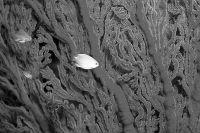Lovelock’s latest provocation
2007/10/06 Galarraga Aiestaran, Ana - Elhuyar Zientzia

James Lovelock was known in the 1970s when he presented his Topic Theory. According to him, the Earth is a living system, able to self-regulate and tends to balance. At first, scientists considered the idea to be insane, but then many have recognized that Lovelock may not be entirely wrong. Somehow, this vision of the Earth helps to understand the evolution of the planet.
But last year, with the book The Revenge of Gaia, it again altered the people. According to him, the future of the planet is very black; for example, it foresees that by 2050 the ice of the poles is melted and London is submerged. And it is clear that climate change has been produced by the human being itself.
In any case, Lovelock is not desperate, but believes there are ways to help save the Earth from the catastrophe. One of them is the substitution of fossil fuels for nuclear energy. This idea also provoked a great revolt; for many it was incredible that the father of Gaia theory was in favor of nuclear energy. However, Lovelock considers it the best option to combat climate change, since nuclear energy does not emit carbon dioxide into the atmosphere unlike other sources.
Tubes in the ocean
With the passage of time the waters have calmed down a little and it seems that it is not such a far-fetched proposal. In fact, even though nuclear energy does not enjoy great social acceptance, other scientists have shown themselves in favor of it and several governments, including the British, are studying this possibility.
However, the substitution of fossil fuels for nuclear energy would take quite a long time and Lovelock believes the countdown is already underway, that is, it is urgent to take measures to combat climate change. For this reason, he has now shown support for mixing the water of the sea in a letter sent to the journal Nature.

In addition, this time it has not appeared alone, since the letter is signed by two people, one is Lovelock itself and another is Chris Rapley, director of the British Science Museum and former director of the Antarctic Research Organization.
The title of the letter is: Ocean ducts can help the Earth heal. They say that efforts to reduce carbon dioxide emissions are useless due to the changes produced by the human being and the inertia of the system, despite their good intention. A harder drug is needed. And the drug they propose is the tubular filling of the ocean.
These tubes would be free or united at sea. They would have between 100 and 200 meters in length and 10 meters in diameter and would have a valve. The movement of the waves would allow the deep waters to surface through the pipes. The bottom waters are richer in nutrients than the superficial ones, so the algae would increase. The algae would absorb carbon dioxide, thus reducing the concentration of this gas in the atmosphere. Moreover, the algae would produce dimethyl sulfide; as the dimethyl sulfide the nucleus of the clouds would produce the clouds that would reflect the sunlight.
Both scientists say that the Gulf of Mexico is the ideal place to place the tubes. This is because by increasing the deep waters, the surface waters cool, so it is considered that fewer hurricanes would occur when the water is hot.
Unknown consequences Unknown consequences
But this idea is not entirely original. The company Atmocean has already made and tested this type of tubes in the US. An estimated 134 million tubes per year are needed to remove one-third of carbon dioxide emissions from the atmosphere due to human activities.

In addition to sealing the ocean with clouds, there are other technological proposals to combat global warming: enrich the sea with iron to increase algae; install umbrellas or mirrors in the sky to prevent sunlight from reaching the earth's surface; and spray the sulfate into the atmosphere to cause clouds.
These technologies are not very developed and no one knows the consequences that could derive from their application. The mixture of marine waters can also have harmful effects. Lovelock and Rapley recognize that the dissolution of atmospheric carbon dioxide in the sea can cause water acidification, resulting in damage to marine ecosystems.
What's more, according to a researcher at the Institute of Oceanography, Woods Hole, the deep waters contain a lot of inorganic carbon, and when the pressure is higher than at the bottom, bubbles would occur and carbon dioxide would be released into the air. Therefore, he considers that the mixture of water is useless.
Lovelock may intend to agitate society so that people can protect measures against global warming. However, some experts consider that such statements can have an opposite effect, since people may think that the solution is in technological advances, so they will not try to reduce energy consumption. At least one thing is clear: If Lovelock's intention was to provoke debate, he has achieved the goal.
Published in Gara

Gai honi buruzko eduki gehiago
Elhuyarrek garatutako teknologia






